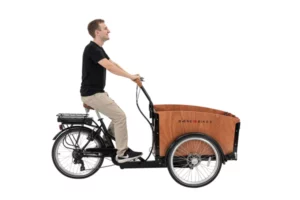Equality and the Electric Bike
When I first arrived in Denmark, you could shut down any dispute in Denmark by appealing to the common good. Solidarity – solidaritet– and fælleskab, or community, or even samfundssind, societal spirit.
These were magic words, and they still are, particularly with the older generation that built Denmark’s welfare state. If you want to convince this generation of anything, just make a reference to solidarity and community and societal spirit. Works like a charm.
What about “Jante Law”?
I’m often asked if the younger generation is as dedicated to these principles as their elders, and if they still follow the Jante Law.
Jante Law is not really a law – it’s like a legend, in which people living in Denmark are not supposed to act like they’re better than anyone else, or smarter than anyone else, or know more than anyone else.
This, of course, is tricky if you actually are better than someone else, or smarter than someone else, or know more than someone else. But the idea is, don’t try to speed ahead of others. We all move at the same rate.
Young people aren’t too keen to put up with that, in particular in an environment where they are competing internationally.
For many Danish young people, the idea that all Danes are equal and we must all move together, at the same pace, seems outdated.
And one contemporary example is the rise of the electric bike.
In their self-image, Danes are bike riders
Denmark is famous for its love of biking – after all, it was a Dane who won the Tour De France this year, the second year in a row. The sad truth is, there are more cars than ever on the roads in Denmark and the number keeps growing. But in their self-image, Danes are bike riders.
And they’ve invested in an excellent network of bike lanes many places in the country, and in cities like Copenhagen, Aarhus, and Odense. In these cities, raised bike lanes are in place along almost every major street and they’re usually about 1.7 meters wide – big enough for one pedal bike to pass another pedal bike, with a little ring from a bell. Ding-ding-ding.
These lanes have always been shared to some extent, with rollerbladers when that was big, but also motorized wheelchairs, mopeds delivering somebody’s food, that’s old news.
Cargo bikes weigh up to 50 kilos

An electric cargo bike
What’s new is that this thin space must be now shared with electric bicycles, a lot of them. Statistics Denmark says one out of eight Danish families now owns some type of electric bike.
Some look like an ordinary one-person bike, but a bit sturdier and heavier; they can weigh up to 28 kilos, versus maybe half that for a pedal bike. But many electric bikes are much bigger. They are big cargo bikes with a large box on the front that can fit up to 3 children plus an adult driver. They can weigh up to 50 kilos.
Legally the solo electric bikes can go up to 45 kilometers an hour, but they are often illegally modified to go 60 kilometers an hour and above. (That’s 37 miles an hour for my U.S. readers).
So there you are, pumping away on your little pedal bike in the bike lane, and somebody goes WHOOSH past on an electric bike emitting that little electric vehicle high-pitched buzz. Eeeeeeee…..
I almost fell into the grass
This happened to me this weekend. I was on my way to the bakery to get some nice fresh Danish pastry, when I was swept aside in the bike lane by a large electric cargo bike driven by a middle-aged woman.
She shot past me, her bike emitting that little electric whine. Eeeeee….. I almost fell into the grass beside the bike lane.
It turned out she was also on her way to the bakery, although she arrived a full 60 seconds before I did.
It’s wonderful to go so fast, isn’t it? she said as she parked her bike.
Wonderful for you, I responded.
Ankle nearly removed
Now, I know I sound grumpy, but I just about had my ankle removed by another electric bicyclist earlier today, and I’m not the only one. An acquaintance is on crutches after another encounter with an electric bike. According to Politiken, the biggest left-wing newspaper in Denmark, bikes are becoming a much greater source of traffic accidents as electric bikes become more popular.
For those of you who remember your physics formulas from school, p=mv, momentum equals mass times velocity. A 50 kilogram cargo bike doing its maximum 25 kilometers an hour or so ramming into someone’s leg, or someone’s dog, or someone’s kid….is not good.
People who have electric bikes really like them
The long-term solution is probably widening the bike lanes, which are in general very crowded these days, but that can’t be done overnight. Alternately, some areas in the Netherlands lowered car traffic speeds to what an electric bike could handle, then sent the electric bikes out of the bike lanes and into the street with the cars.
You could limit electric bike use to the elderly or the disabled – but that would not be a popular move.
People who have electric bikes really like them. Office types can ride them to work, for example, without arriving all sweaty, as they would on a pedal bike.
Heroes of the green transition
And the truth is, people who ride electric bikes see themselves as heroes – because they’re not driving a car. They see themselves as part of the green transition. If they knock over a few pedestrians or old-fashioned pedal-bikers who are also part of the green transition, well, that’s just the price of progress.
Of course, problems with electric bikes and scooters aren’t unique to Denmark, you hear similar complaints from many places around the world, but what is unique about Denmark is that we are famous for being a trust-oriented society that is interested in the common good.
We’re supposed to be equal. Solidarity. Community. Societal Spirit.
But it seems that what has now been accepted in Denmark’s bike lanes is a concept that is used to be very udansk, or un-Danish….
That some people simply go faster than others.
AI Image created by Stable Diffusion. Prompt: Jonas Vingegaard winning a bicycle race on an electric cargo bike in Denmark





